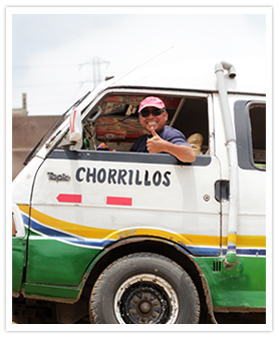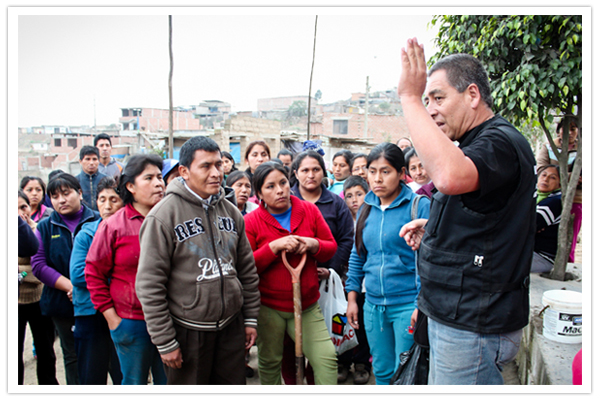We first met Rosa Muñoz, the leader of a small community called Santa Cruz, when she approached us with a proposal. Having learned of MEDLIFE’s staircase projects in other urban areas surrounding Lima, Rosa sought out MEDLIFE Project Coordinator Carlos Benavides in July of 2011 to suggest that her burgeoning community be the next to receive assistance.
Rosa knew exactly what she wanted. For her community, she proposed a set of three staircases that would allow residents to safely access their homes. Although MEDLIFE staff members were at first hesitant to undertake the project, due to the community’s daunting altitude and distance from navigable roads, we eventually agreed to begin construction.
Rosa headed weekly meetings in Santa Cruz in the months leading up to the projects, inspiring community members to participate and volunteer. Wearing her characteristic black hat despite the heat of Lima’s summer, she worked tirelessly toward the completion of all three staircase projects by carrying buckets, mixing cement, positioning handrails, painting, and planting trees.
For many foreigners, several of whom are taught to value autonomy and individual achievement, the way that leaders like Rosa mobilize their communities to enact change – passionately and without pay – is striking.
“I suppose it’s like why you are here in Peru,” said Daniel “Amoy” Chirinos, a member of the 12 de Junio settlement in Lima, attempting to explain how his community organized the resident-led construction of a new public bathroom. “Some people just have a desire and commitment to help.” Daniel explained that his neighbors nicknamed him “Amoy,” a derivative of the Spanish word for love, because it’s something that he tries always to reflect.

Although community members don’t tend to articulate it, there are words that describe this tradition of mutual support. Minka, or minga, is a Quechua word meaning collective work for the common good. Dating back to the original migrants from the Andes and jungle regions of South America, mingas were used to construct communal facilities and irrigation canals, to harvest on shared land, or to care for the sick and aging population. Due to heavy migration within Peru, it has also spread toward cities on the coast, creating a cultural commitment to mutual aid that many residents feel has always been there.
Residents in the asentamientos humanos (informal settlements) surrounding Lima, where MEDLIFE works, also use an inclusive approach to community decision-making. By means of general assembly they jointly elect a group of 10-12 community leaders and promoters; these individuals are in charge of distinct areas ranging from neighborhood security to social assistance. Because development of these urban communities required, and continues to requires the help of all participants, female participation has been relatively easily accepted. A Centro de Estudios y Promoción del Desarrollo (DESCO) report noted that by the 1980s, women were already serving in important community leadership positions.
The community’s overall main leader or leaders, called dirigentes, also meet once a week with a representative from the local government assigned to their district. Although these settlements were not always formally recognized by the government, residents have learned how to lobby for official recognition and resources.
Community leaders can serve an unlimited number of two-year terms in these voluntary roles, as long as they are elected by popular consensus. Prior to acting as MEDLIFE’s own Project Director, Carlos Benavides spent 12 years working as a community leader. During this time, Carlos served as head of his household, community leader, and as a volunteer watchman working alongside local police forces. This high level of family and neighborhood organization provides the settlements with a great amount of social capital — one of the communities’ main assets.
Yet, since MEDLIFE began working in the urban slums of Lima in 2010, we have seen many different kinds of community dynamics. Alongside dedicated leaders, we have also encountered dirigentes who don’t care about improving their communities, or worse, who lie to and steal from their residents.
One community leader from 12 de Junio repeatedly pointed out that each community, although structured similarly, is unique. “When you speak about Peru, or Lima, or even this district,” he said, “it’s impossible to generalize.”
Carlos also attributes our most successful initiatives to solid community leadership. “The first thing I look for [in starting a development project],” says Carlos, “is the need. Then I meet with the community leader(s) to find out how they work, to find out how well they are organized.”
For many community residents, the structure they have developed seems to be a simple matter of mutual respect and common sense. Yet for those in international development, it is a unique leverage point in the effort to upgrade urban slums. A 2003 World Bank report lists Peru’s “long tradition of mutual help” as an important factor in why Lima’s informal settlements have experienced more rapid urban development compared to other Latin American cities. A research paper presented at the American Sociological Association Annual Meeting also notes that “reciprocity is considered a key characteristic of traditional Andean society,” and that “reciprocity remains a uniquely appropriate practice that contributes to individual livelihood making, group solidarity, and community development.”
Likewise, MEDLIFE capitalizes on this value of shared responsibility, leaning heavily on motivated local leaders to organize, plan, build and maintain our community development projects. We have developed strong ties with many residents who remain an integral and often under-recognized element in the promotion of our Mobile Clinics, execution of our educational workshops, and completion of our development projects.
The importance of these leaders is not lost on our volunteers. Last week, on the last day of our most recent Mobile Clinic in Lima, a student gave a short speech on behalf of his university’s student group.
“Thank you,” he said to the community residents who had gathered to inaugurate our newest staircase project, “for all of your hard work and organization. Thank you for letting us be part of this experience.”
“But most of all, thank you for showing us what it means to be a community.”

